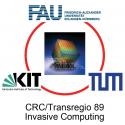Invasive Computing - CRC/Transregio 89

Friedrich-Alexander-Universität Erlangen-Nürnberg (FAU)/SFB/Transregio 89: Invasives Rechnen (InvasIC)
Cauerstraße 11 / Lehrstuhl für Informatik 12/ (Hardware-Software-Co-Design)
91058 Erlangen
Germany
In the Transregional Collaborative Research Centre “Invasive Computing” (abbr. “InvasIC”) scientific researchers from the Friedrich-Alexander-Universität Erlangen-Nürnberg, the Technische Universität München as well as the Karlsruhe Institute of Technology investigate together a novel paradigm for the design and programming of future parallel computing systems.
Its unique characteristic is to give a programmer explicit handles to specify and argue about resource requirements desired, or required in different phases of execution: Using an invade command, an application may instruct the operating system to claim a set of processors, memory and communication resources for being allocated for a, by default, subsequent exclusive use. In an infect phase, the application workload is then spread and executed on the obtained claim of resources. A retreat command finally frees a claim again, and the application may resume sequential execution. To support this idea of self-adaptive and resource-aware programming, not only novel programming concepts, languages, compilers, and operating system concepts had to be developed from scratch, but also revolutionary architectural changes in the design of MPSoCs (multiprocessor system-on-a-chip) including mechanisms to allocate and isolate resources on demand.
Find out more about the CRC/Transregio 89 on www.invasic.de.



